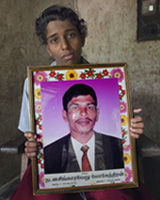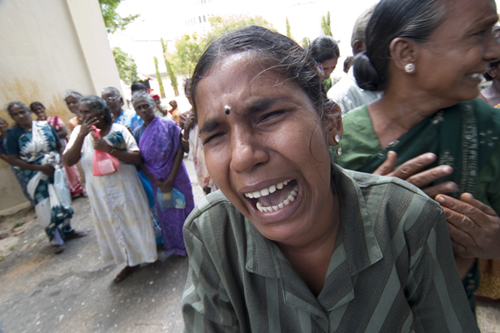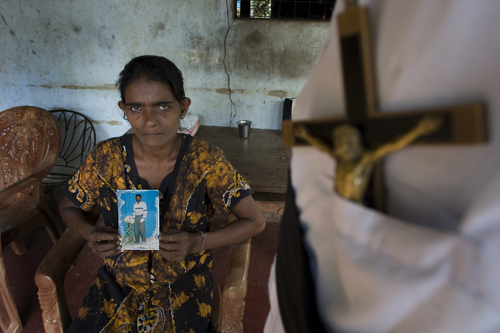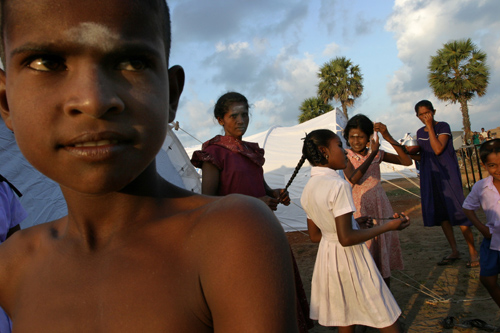Ilankai Tamil Sangam30th Year on the Web Association of Tamils of Sri Lanka in the USA |
||||||||||
 Home Home Archives Archives |
Sri Lanka's Human Rights VoidText & pictures by Will Baxter, TowardFreedom, January 29, 2008
Outside the Bishop’s residence about a hundred Tamil women are crying and wailing, many of them clutching copies of death certificates or missing person’s reports to their chests. Crumpled up in their fists are photocopies of ID cards belonging to their husbands, their sons, their fathers—all murdered, abducted, or officially classified in a log somewhere as ‘missing.’ These women have all come here with the same intention: to try and gain an audience with the visiting UN High Commissioner for Human Rights, Louise Arbour, to tell their story and to plead for justice. In Jaffna, when someone disappears, they unfortunately have a way of never turning up again. Making the atrocities known is often the only solace these women can have. Sri Lanka has plunged back into full-blown war after the government announced its decision to unilaterally withdraw from the 2002 Ceasefire Agreement on Jan. 16, 2008. The government said it ended the cease-fire because the Liberation Tigers of Tamil Eelam (LTTE), who are fighting for an independent homeland in the north, had violated the agreement thousands of times while using it to regroup and prepare for an extended conflict.
International aid donors have expressed concern that ending the truce, brokered by Norway, will result in widespread human rights abuses against civilians. Donors also say there can be no military solution to the conflict. More than 5,000 people have been killed in Sri Lanka since early 2006 when peace talks failed, pushing the overall death toll since 1983 to approximately 70,000. A few meters away from the gathering of women outside the Bishop’s residence, half a dozen Sri Lankan soldiers stand by an iron gate, looking warily from one another and then back at me and my camera. Obviously, they are not quite sure what to do about the fact that I am there. There are sentries at every entrance to the church compound because security has been beefed up for the meeting at the Bishop’s residence between Arbour and a number of local leaders, which means I either belong there, or I have slipped in somehow. It’s very clear, though, that I am not a welcome sight.
Over the past few years, freedom of the press in Sri Lanka, much like the concept of human rights, has devolved into mere abstract theory. The already volatile situation in the country has been compounded by a general hostility and suspicion toward the media. In 2007 alone, six journalists were killed in Sri Lanka, making it the third most dangerous country for journalists behind Iraq and Somalia. The conflict has also received very little attention in the international news, especially regarding human rights abuses against civilians. This is partly because of the ridiculous restrictions imposed by the government on what journalists can and cannot cover. The situation is likely get worse now that the government has officially abandoned the ceasefire agreement. Perhaps not knowing what to do, the soldiers allowed me to photograph for awhile, but I knew that very soon I would be asked to leave. A couple of days before this, two video journalists who had gone through the process of acquiring permission from the Ministry of Defense were ‘detained’ upon arrival at the airport in Jaffna and then sent back to Colombo the following day by the local area commander.
t was already obvious the military didn’t want to draw attention to this scene. The church compound, which sits on a plot of land about the size of a football field, is in a sort of L-shape. Arbour’s car would be approaching from the north, so the soldiers had done their best to hide these women from view by shooing them around the south side of one of the larger buildings. These women are representative of a much larger contingent of Tamils in Sri Lanka who have lost family members during the most recent upsurge in violence. Murders, abductions, kidnappings, forced recruitment, arbitrary arrests and the recruitment of child soldiers all occur in the north and east of the island on a daily basis and the victims are, almost without fail, noncombatant Tamil civilians. Ironically, it is not the group labeled ‘terrorists’ by the US, UK and European Union—the LTTE—who are responsible for the vast majority of these human rights violations, but rather, it is the Sri Lankan government and the paramilitary groups they support. These paramilitaries, more commonly known as the Karuna Faction, work in small groups and are often given a list of Tamil civilians—the objective being to kill any person on the list, or several, or all, depending on how enthusiastic they are about their tasks. The list for abductions, on the other hand, could simply list a family name. The paramilitaries will show up at the family’s house and if the chosen male is not present, often they will take a brother in his place. They work mostly at night when a strict curfew is in effect, and in the early morning hours. The Sri Lankan military turns a blind eye to such incidents which often take place only a short distance from checkpoints or military posts. These paramilitaries actually have offices as well, and a ‘political wing,’ the Tamil Makkal Viuthailai Pulikal (TMVP). Without a hint of irony, their offices are usually located close to government military posts, where they feel the safest. Previously the TMVP had offices in more secluded locations, but the LTTE had a predilection for blowing them up.
The LTTE, of course, are also complicit in a range of human rights abuses including extrajudicial killings, abductions and the use of child soldiers. On Jan. 15, a day before the Sri Lankan government officially withdrew from the ceasefire, Arbour released a statement in which she warned all warring parties in Sri Lanka to protect civilians against arbitrary detention, forced displacement, forced disappearances, torture, the recruitment of child soldiers and said violators could be prosecuted for war crimes. Back at the Bishop’s residence, the soldiers eventually do decide to speak to me, albeit in very broken English. I counter by pretending I don’t understand what they are asking me, which buys me a bit more time. But after I’ve been there about twenty minutes, a soldier arrives on a motorbike and strides right on over to where I am standing. He asks for my I.D., so I give it to him. He asks if I have permission to be there, at the church, and I tell him I am not planning to photograph the High Commissioner, or the meeting, just the gathering of women. He says, "You cannot stay here any longer." To this, I protest for a minute or so, and try to explain to him that I have permission to photograph in and around Jaffna until he becomes agitated and barks angrily at me "You go!" effectively sending me on my way. Granted, these events took place in a high security zone, but the fact that a journalist would be forbidden to photograph a public gathering of this kind is completely ridiculous. Blatant censorship, however, has become common practice in Sri Lanka these days and journalists are rarely given uninhibited access to conflict areas. I heard later from a contact at one of the UN offices in Jaffna that Arbour decided to get out of her vehicle as it approached the Bishop’s residence and talk to some of these women, much to the chagrin of the military. My contact’s comment was, "You could tell those women just felt like telling her their story was the most important thing they could do." Unfortunately, the Sri Lankan government also knows the inherent value of stories like these, which is perhaps the reason they are so hell bent on silencing them. |
|||||||||
|
||||||||||



